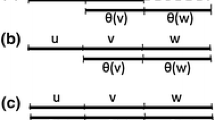Abstract
Two specific mappings called doubler f d and linearizer \(f_{\ell}\) are introduced to bridge between two kinds of languages. Specifically, f d maps string languages into (double-stranded) molecular languages, while \(f_{\ell}\) performs the opposite mapping. Using these mappings, we obtain new characterizations for the families of sticker languages and of Watson-Crick languages, which lead to not only a unified view of the two families of languages but also provide a helpful view on the computational capability of DNA complementarity. Furthermore, we introduce a special type of a projection f pr which is composed of f d and a projection in the usual sense. We show that any recursively enumerable language L can be expressed as f pr (L m ) for a minimal linear language L m . This result can be strengthened to L = f pr (L s ), for a specific form of minimal linear language L s , which provides a simple morphic characterization for the family of recursively enumerable languages.

Similar content being viewed by others
References
Freund R, Păun Gh, Rozenberg G, Salomaa A (1997) Watson-Crick finite automata. Proceedings of Third DIMACS workshop on DNA based computers, pp 305–317
Freund R, Păun Gh, Rozenberg G, Salomaa A (1998) Bidirectional sticker systems. Proceedings of Pacific symposium on biocomputing, pp 535–546
Hoogeboom HJ, Vugt NV (2000) Fair sticker languages. Acta Informatica 37:213–225
Kari L, Păun Gh, Rozenberg G, Salomaa A, Yu S (1998) DNA computing, sticker systems, and universality. Acta Informatica 35:401–420
Kuske D, Weigel P (2004) The role of the complementarity relation in Watson-Crick automata and sticker systems. Lect Note Comp Sci 3340:272–283
Martin-Vide C, Păun Gh, Rozenberg G, Salomaa A (1998) Universality results for finite H systems and for Watson-Crick finite automata. In: Păun Gh (ed) Computing with bio-molecules, theory and experiments. Springer-Verlag, Berlin
Onodera K, Yokomori T (2006) Linearizer and doubler: Two mappings to unify molecular computing models based on DNA complementarity. Lect Note Comp Sci 3892:224–235
Păun Gh (1997) Marcus contextual grammar. Kluwer Academic Publishers, Dordrecht
Păun Gh, Rozenberg G, Salomaa A (1998) DNA Computing. New computing paradigms. Springer-Verlag, Berlin
Rozenberg G, Salomaa A (eds) (1997) Handbook of Formal Languages. Springer-Verlag, Berlin
Salomaa A (1998) Turing, Watson-Crick and Lindenmayer: Aspects of DNA Complementarity. In Springer Series in Discrete Mathematics and Theoretical Computer Science, Proceedings of Unconventional Models of Computation, pp 94–107
Sakakibara Y, Kobayashi S (2001) Sticker systems with complex structures. Soft Comput 5:114–120
Sempere JM (2004) A representation theorem for languages accepted by Watson-Crick finite automata. Bull EATCS 83:187–191
van Vliet R, Hoogeboon HJ, Rozenberg G (2005) Combinatorial aspects of minimal DNA expressions. Lect Note Comp Sci 3384:375–388
Acknowledgements
Many thanks are due to two anonymous referees for their valuable comments and suggestions that greatly improved an early draft of this paper. This work is supported in part by Grant-in-Aid for Scientific Research on Priority Area no. 14085205, Ministry of Education, Culture, Sports, Science and Technology of Japan and for the Research Institute for Science and Technology of Tokyo Denki University with no.Q07J-05.
Author information
Authors and Affiliations
Corresponding author
Additional information
A preliminary version of this article appeared in Onodera and Yokomori (2006).
Rights and permissions
About this article
Cite this article
Onodera, K., Yokomori, T. Doubler and linearizer: an approach toward a unified theory for molecular computing based on DNA complementarity. Nat Comput 7, 125–143 (2008). https://doi.org/10.1007/s11047-007-9057-5
Received:
Accepted:
Published:
Issue Date:
DOI: https://doi.org/10.1007/s11047-007-9057-5




